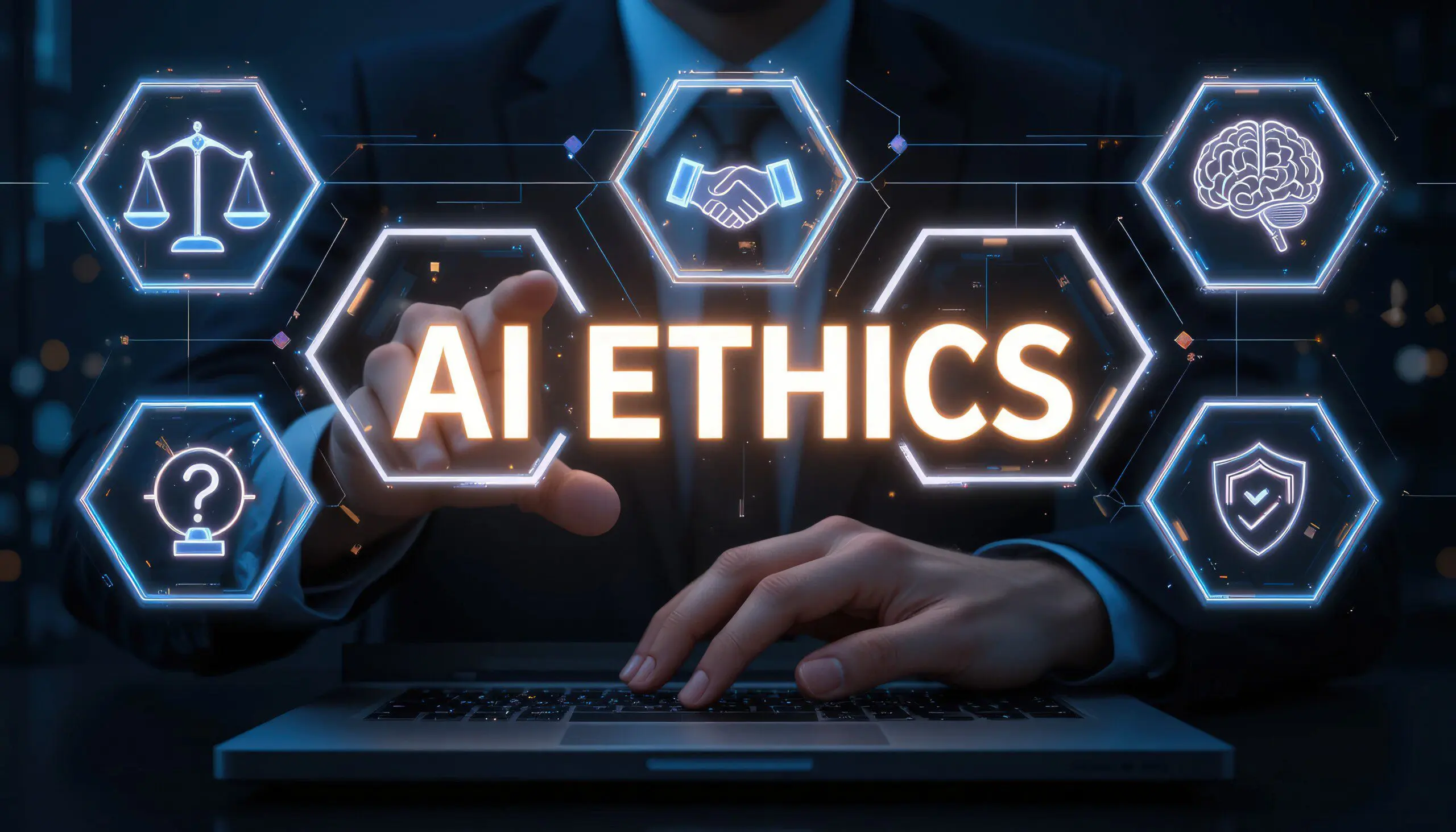Artificial intelligence (AI) is everywhere now — in the apps you use, the ads you see, the hiring software companies use, and even in public services such as policing and benefits administration. That ubiquity raises big questions: Is AI fair? Who’s accountable when something goes wrong? Do you have a right to know when a machine made a decision about you? This article walks Americans through the ethics of AI in clear, reassuring language, gives actionable steps you can take as a citizen, consumer, employee, and business owner, and summarizes research from leading universities and U.S. agencies so you can separate hype from evidence.
Why AI ethics matters to everyday Americans
AI systems influence decisions that matter: who gets a job interview, whether you’re offered a loan, what medical options you’re shown, how social media prioritizes news in your feed, and even whether you’re flagged for extra scrutiny at the border. When those systems make mistakes or reflect unfair patterns in data, they can reinforce discrimination, invade privacy, or cause economic harm. Understanding the ethics of AI isn’t just for technologists — it’s essential for consumers, workers, parents, and voters.
Public concern about AI’s social effects is significant: recent national polling shows many Americans are worried about job disruption, privacy, and the potential misuse of AI; a substantial share want more control and clearer rules about how AI is used. Pew Research Center
Core ethical principles (simple, practical definitions)
Below are five commonly invoked principles that show up in U.S. policy guidance and academic work. You’ll see these repeated in frameworks and proposals — they’re the backbone of ethical AI.
- Safety & Reliability — Systems should work as intended and be tested to avoid harmful failures.
- Fairness & Non-discrimination — AI should not systematically disadvantage people on the basis of race, gender, age, disability, or other protected characteristics.
- Privacy & Data Protection — People’s data should be collected and used with consent, clear limits, and safeguards.
- Transparency & Explainability — People should be informed when decisions are automated, and—where feasible—given understandable explanations.
- Human Oversight & Accountability — There should be mechanisms to review, contest, and correct automated decisions.
These principles are embedded in U.S. policy guidance such as the White House’s “Blueprint for an AI Bill of Rights,” which summarizes how AI should protect civil liberties and democratic values. The White House
How governments and researchers frame AI ethics (table)
| Source | Focus | Practical guidance for Americans |
|---|---|---|
| White House — Blueprint for an AI Bill of Rights | Civil rights, notice, explanation, human alternatives | Citizens should expect notice when systems make high-impact decisions and be able to seek human review. The White House |
| NIST — AI Risk Management Framework (AI RMF) | Risk-based approach for industry & agencies | Organizations should identify risks to people and manage them through tests, documentation, and mitigation. NIST |
| MIT Media Lab (research like Gender Shades) | Demonstrated bias in facial recognition | Research shows some AI tools perform worse on women and people of color; vigilance and auditing are needed. MIT Media Lab |
| Stanford HAI (research & commentary) | Human-centered approaches & fairness trade-offs | Technical work shows “equal treatment” is not always fair — context matters for defining fairness. Stanford HAI |
(These frameworks complement one another: the White House emphasizes rights and democratic values; NIST gives operational steps; universities provide empirical evidence of harms and trade-offs.) NIST+1
What the research says — evidence you can trust
University and peer-reviewed research gives us concrete, replicable facts about AI harms and mitigation:
- Bias in facial recognition: MIT’s Gender Shades and related Media Lab work found that commercial face-recognition systems had higher error rates for women and darker-skinned people, proving that biased training data produces biased outcomes. This is not an isolated problem — it’s an observable pattern across systems trained on non-representative datasets. MIT Media Lab
- Fairness trade-offs are real: Stanford researchers explain that there’s rarely a one-size-fits-all fairness metric. Different fairness goals (e.g., equal false positive rates vs. equal treatment across groups) can conflict, meaning designers must choose priorities in context and document trade-offs. That’s why human-centered policy decisions matter. Stanford HAI
- Risk management is practical and necessary: NIST’s AI Risk Management Framework provides a stepwise, risk-based approach organizations can use to identify, measure, and mitigate harms before deployment. This moves ethical goals from vague ideals into engineering practice. NIST
These university and government studies make one thing clear: ethical AI isn’t just moralizing — it’s measurable, testable, and improvable.
Real-life harms (concrete examples Americans should know about)
- Credit and lending: Automated scoring that uses proxies (like ZIP codes) can reproduce redlining patterns, making loans harder to get for marginalized communities.
- Hiring and HR systems: Some resume-screening tools have penalized applicants from certain groups because they learned from past biased hiring decisions.
- Criminal justice tools: Risk-assessment algorithms have been criticized for inflating risk scores for Black defendants in certain datasets.
- Health care models: Clinical prediction models trained on non-representative hospital data may underdiagnose or mis-treat patients from underrepresented groups.
- Surveillance & privacy: Facial recognition and location-based inferences can erode anonymity and chill civic participation.
These issues are not hypothetical; multiple studies and field reports confirm such harms and underscore the need for transparency, oversight, and remedies. MIT Media Lab+1
What Americans can do — a practical checklist
Whether you’re a consumer, worker, or voter, here are concrete things you can do now.
For consumers and citizens
- Ask for notice. If a company or agency is using automated decision-making that affects you, ask whether a model is being used and what data it uses. The AI Bill of Rights recommends transparency as a baseline expectation. The White House
- Protect your data. Read privacy settings, opt out of unnecessary data sharing, and use privacy tools (browser privacy settings, password managers).
- Document harms. If you suspect an automated system treated you unfairly (denied loan, misidentified in video, etc.), save records and consider contacting consumer protection groups or your state attorney general.
- Vote and advocate. Support candidates and policies that prioritize civil liberties and oversight for AI.
For workers and employees
- Request human oversight. If your employer uses AI for performance evaluation or monitoring, ask for human-review mechanisms and explanations of how the system works.
- Push for training and transparency. Employers should provide training on AI’s limits and the rights of workers. Union or worker groups can negotiate AI-use clauses.
- Document changes. If AI changes your job description or evaluation criteria, request written notice and an opportunity to appeal.
For small business owners and technologists
- Use the NIST AI RMF. Adopt a risk-based approach to test for fairness and reliability before deploying any automated decision system. NIST
- Keep human-in-the-loop processes. Where stakes are high, retain human decision-makers and robust feedback channels.
- Audit and log. Keep logs and run regular audits for disparate impacts and failures.
7 Practical steps for organizations to build ethical AI (listicle)
- Map the decision pathway. Identify where data is collected, how models are trained, and where decisions affect people.
- Define acceptable risk. Explicitly state what harms are unacceptable (e.g., systemic denial of services to a protected class).
- Test on diverse data. Use representative test sets and simulate edge cases before deployment.
- Document design choices. Keep “model cards” and “datasheets” explaining model limits and intended use.
- Enable contestability. Provide ways for affected people to challenge automated outcomes.
- Monitor continuously. Post-deployment monitoring catches drift, bias creep, or unexpected side-effects.
- Engage communities. Involve affected communities and civil-society experts early and often.
These are actionable practices recommended by technical and policy institutions because they translate ethical principles into systems engineering. NIST+1
Explainable AI: what “explainable” really means (short primer)
Explainability is the idea that a person affected by an AI decision should be given an understandable reason for that decision. There are two useful levels:
- Local explanations: Why did the system make a particular decision about me? (e.g., “Your loan was denied because your credit utilization exceeded X and your income-to-debt ratio was Y.”)
- Global explanations: How does the system generally behave? (e.g., “This model uses employment length, credit history, and income to score risk; it isn’t designed to use race.”)
Explainability is sometimes technically difficult (complex deep-learning models are not inherently transparent), but it’s a solvable engineering challenge — one that universities and labs are actively researching. When full transparency is impossible, organizations should provide meaningful approximations and human review options. Stanford HAI+1
Who should regulate AI in the U.S. — and how?
Regulation is rapidly evolving. Some countries have comprehensive AI laws; in the U.S., federal agencies (like NIST and the White House OSTP) provide frameworks and guidance, while sector-specific regulators (FTC, CFPB, FDA, etc.) apply rules for unfair practices, financial discrimination, and medical device safety. The federal Blueprint for an AI Bill of Rights is not a law but a policy blueprint advocating civil-rights protections in automated systems; it signals a direction for future laws and agency action. The White House+1
Good regulation tends to be:
- Risk-based — higher stakes get stricter review.
- Tech-neutral — rules focus on outcomes, not specific algorithms.
- Adaptive — regulators update rules as evidence and technology evolve.
- Enforceable — agencies need authority and resources to investigate harms.
Citizens can help by supporting enforcement funding, demanding transparency from companies, and electing officials who prioritize oversight.
Scientific research explained (short case studies)
1. MIT — Gender Shades and facial recognition bias
MIT’s Gender Shades project evaluated commercial facial analysis systems and found notable performance gaps: darker-skinned women experienced much higher error rates than lighter-skinned men. The study demonstrated how skewed training data and design choices yield discriminatory outcomes and sparked new industry standards and moratoria on some uses of facial recognition for policing. MIT Media Lab
2. Stanford HAI — fairness is contextual
Stanford’s human-centered AI work shows fairness isn’t a single metric you can optimize universally. For example, ensuring identical error rates for every demographic (a mathematical fairness goal) may not align with social goals like reducing historical inequity. The implication: technical teams must work with ethicists, community stakeholders, and policymakers to choose fairness standards appropriate to the context. Stanford HAI
3. NIST — turning ethics into engineering practice
NIST’s AI RMF translates ethical goals into operational steps: identify stakeholders, analyze harm scenarios, run tests and audits, and document mitigation strategies. It’s practical guidance meant to reduce real-world harms and help organizations answer “how” rather than only “why.” NIST
Table: Quick guide — “If this happens to you, do this”
| Problem you face | Immediate action | Where to escalate |
|---|---|---|
| Denied loan and suspect algorithmic reason | Request explanation; ask for human review; request copies of documents used | Lender’s compliance officer; CFPB (consumer financial protection) |
| Wrongful content/identity moderation | Take screenshots; appeal through platform process | Platform’s appeals; state AG for repeated harms |
| Suspect biased hiring tool | Request transparency about tools; ask for alternative review | Company HR/EEO; EEOC (if discrimination likely) |
| Health prediction seems wrong for your demographic | Ask clinician about model use; request second opinion | Hospital patient advocate; state medical board |
| Targeted surveillance / facial recognition misuse | Document location and time; request removal/opt-out if offered | Local civil liberties groups; state AG |
Frequently Asked Questions (FAQs)
Q: Is AI regulation the same as banning AI?
A: No. Regulation seeks to reduce harms while preserving benefits. Most frameworks (including the White House blueprint and NIST) promote safe, explainable, and rights-respecting AI rather than blanket bans. The White House+1
Q: Can I sue a company if an AI system harms me?
A: Possibly. Lawsuits can be based on discrimination, negligence, consumer-protection violations, or other legal theories. Document the harm and consult consumer-advocacy groups or an attorney experienced in civil-rights or tech cases.
Q: How can I tell if a company is using AI in a way that affects me?
A: Companies may disclose AI use in privacy policies or product terms, but disclosures vary. Ask directly (email, customer support) and request plain-language explanations. Public-sector AI use usually triggers additional transparency rules — keep an eye on local government notices. The White House
Q: Will AI take all the jobs?
A: Research shows AI will transform many jobs — automating some tasks, creating others, and changing how work is organized. Public opinion is mixed, and workplace policies (retraining, union negotiations, regulation) will shape outcomes. Staying informed and acquiring adaptable skills helps. Pew Research Center+1
Q: What should I tell my employer if they want to introduce AI tools at work?
A: Ask for transparency about what the tool does, data sources, how it affects evaluations, human oversight, and opportunities to appeal decisions. Request training and protections for workers’ privacy and job security.
How to stay informed and involved
- Follow reputable sources: university centers (Stanford HAI, MIT Media Lab, Berkman Klein at Harvard), NIST, and consumer-protection agencies. Stanford HAI+2MIT Media Lab+2
- Attend public meetings and town halls where local governments discuss surveillance and procurement of AI systems.
- Support watchdogs and civil-society groups that audit AI and advocate for rights-respecting deployment.
- Encourage transparency: ask companies and public agencies to publish model cards, impact assessments, and redress mechanisms. NIST and the White House both emphasize documentation and transparency as core to trustworthy AI. NIST+1
Quick glossary (helpful terms)
- Algorithmic bias: Systematic errors that produce unfair outcomes for certain groups.
- Model drift: When a model’s performance degrades over time because the input data distribution changes.
- Explainability / interpretability: The degree to which a human can understand the cause of a model’s decision.
- Model card / datasheet: Documentation describing a model’s intended use, training data, performance, and limitations.
- Human-in-the-loop: A design where humans supervise or can override automated decisions.



